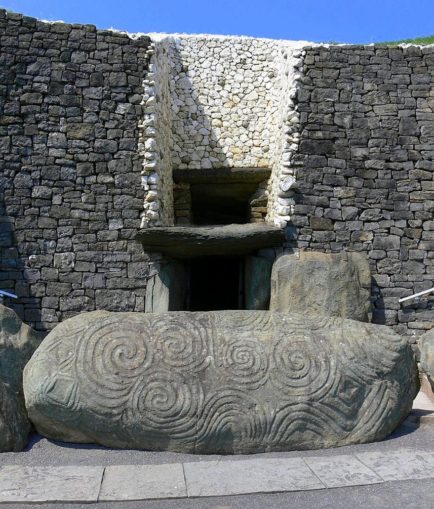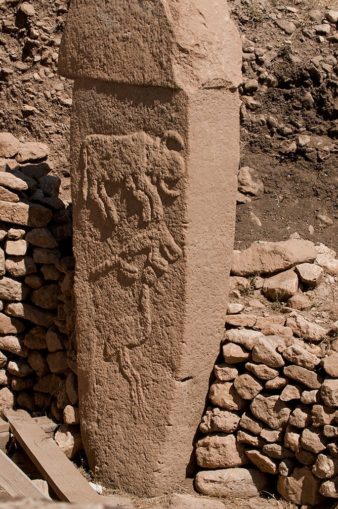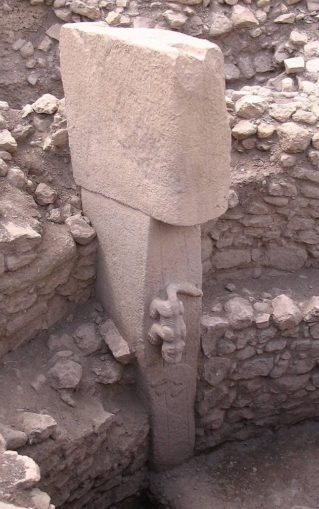
This is a rather niche book, but I know there are (at least) a few Puffins keen on archaeology, so I thought it might be of interest. It explores, as the subtitle says, ‘consciousness, cosmos and the realm of the gods’ during the neolithic period. Written by two Seth Effrican professors, it was praised when it came out for its readability – and indeed it is readable (in relation to other archaeological works, that is) but it can also, like them, tend to be rather ponderous and impenetrable in parts.
A bit of background: once upon a time in archaeology, analyses concentrated on the material remains only. In this case, neolithic monuments would have been recorded (ie mapped, drawn, photographed and measured), categorised by being fitted into a group of others that were most like themselves, any associated features or artifacts would be noted, the site written up and that would largely be the end of it. It was VG Childe in the 1923 who coined the term ‘Neolithic Revolution’, seeing the whole neolithic as a package which arrived in western Europe all at once from the Near East – the domestication of plants and animals, the making of pottery, the construction of huge monumental architecture for a small number of certain selected people. Where you had one, it was assumed, you must have the others. It soon be came clear that things weren’t quite that simple, with the discovery of awkward pre-pottery neolithic cultures like the Natufians, for example, who were fully neolithic apart from the pottery, and, conversely, cultures earlier than the neolithic which did have pottery, but none of the other elements.
Then along came Graham Clarke in the 30s, whose focus of attention went one better – he founded what was called the ‘economic’ approach, which looked more closely at the detail of man’s exploitation of available resources (animal, plant, mineral, stone), to put together a picture of how their society ran, in a material sense: how they produced things, and in what environment. Clarke’s speciality was the Mesolithic (the age immediately before the neolithic) but, even there, he ran into imponderables at his type site ( = exemplar) of Star Carr, which he excavated in the late 40s/early 50s.

Star Carr, near Scarborough in North Yorkshire, is a middle stone age site which dates to around 9000 BC, just centuries after the end of the last ice age. It has become world famous due to its preservation of artefacts found deep in the peat on the shores of what would have then been the prehistoric Lake Flixton. Clark unearthed a now-famous mask made of a deer’s head, with front and antlers attached, bearing a remarkable resemblance to the ones used for many centuries by groups like the Abbot’s Bromley Horn Dancers in Staffordshire. Clearly, these ancient people were not just concerned with material things. What on earth could such a mask have been used for? It was seen as vaguely unscientific to speculate too much about these things in British prehistory at the time, and such finds were usually labelled ‘ritual’ and hurriedly put aside. In recent times, interest in whether we can identify a neolithic religion, and what might constitute the evidence for it, has grown. The authors of this book believe the time is now ripe to delve even deeper, and with a bit more confidence, using cognitive neuroscience (how the brain maps things) as a guide. What did their monuments mean? What messages were they intended to convey? How did the people of the time relate to them?
Whether or not you go along with this book will largely depend on your acceptance or otherwise of the authors’ central premise, which is that certain elements of human consciousness are hardwired universally (ie, common to all humans). They see these as including the idea of a cosmological upper universe (stars, sky, heaven), an earthly realm, and an underworld. These, they feel, are central to all neolithic thought, and are represented in the forms of objects found in that era and the patterns which decorate them.

A picture emerges of a people obsessed with the idea of different states of being (dark to light, life to death and vice versa, youth to age, sleep to waking, water to shore) and the possibility of moving between them. Creatures such as snakes and birds move between incarnations and over thresholds (from eggs into flesh, and then into and over water, earth or air and backp) and this may explain the symbolic importance given to them. One idea which is really new here is that the monuments preceded farming, rather than the other way round, which has always been the standard theory (the conventional idea being that settled farming, unlike nomadic hunting and gathering, could lead to large food surpluses, which in turn led to the availability of personnel and leisure time to build large permanent structures). This new idea is borne out by the recent stunning discovery of the site of Göbekli Tepe, in Turkey, which has massive decorated stones but no sign of agriculture or domestication of animals, being far too early. It seems religious activity may in certain cases have been far more fundamental to people than advances in food production, and may in fact have been the driver which led to the domestication of plants and animals, along with the invention of social hierarchy (some selected experts being elevated to be in charge of ‘access’, whether physical, mental or spiritual, to the mystical realms, etc). Another fascinating finding of the authors (mentioned in their earlier book, The Mind In The Cave) is that, if certain psychoactive drugs are taken, the subjects report seeing certain visions very similar to the patterns inscribed on sites like Newgrange, Co Meath: at different stages of trance, the brain apparently sees zigzags, spirals, multiplying units, merging of two images into one, etc. So, a bit like rave culture, the Neolithic population might have spent its time frequently getting off its head on drugs. The resulting patterns can then be interpreted according to their placement on the monuments. As to what they were taking, psilocybin mushrooms seem a good bet – and it may be relevant that the neolithic is thought to be when beer was invented!

There is quite a lot of (necessary) padding in the book – explaining the terms used and describing the sites mentioned, including Bryn Celli Dhu and Barclodiad y Gawres on Anglesey and the major complex of Bru na Boine (consisting of Newgrange, Knowth and Dowth) in Ireland. These parts are enjoyably done and essential if you are coming from a point of view of not knowing much about this time. The authors do use a lot of social anthropology, in the form of finding parallels in other modern ‘primitive’ societies (the S. African bushmen, for instance) which is a bit of a minefield (these societies might not have been the same in the past, and are not necessarily any sort of model for prehistoric Europe, as they clearly developed – or, some would say, didn’t – along different lines). Many neuroscientists wouldn’t agree that elements of cosmic thought are hardwired into all human brains. So the book is controversial, but the writers make their case well and, as for the long-windedness, a bit of judicious skipping can be done by making use of the subheadings, which are many, to negotiate by whichever elements you find most interesting. Enjoyable if you want to get your teeth into the possibility of something quite deep and abstract, written on the landscape.
© Foxoles 2019
Audio file



